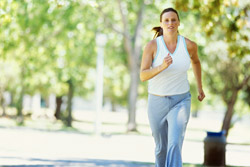- Introduction
- Diet and menopausal symptoms
- Exercise and menopausal symptoms
- Dietary and exercise measures to prevent health conditions in post-menopause
- Tips for menopausal exercise and diet
Introduction
Healthy eating and regular physical activity are an important part of healthy living and important measure for women going through menopause. Regardless of the other treatments menopausal women choose to use, lifestyle measures to improve diet and physical activity should be implemented. These measures are becoming increasingly important as a growing number of women seek alternatives to hormone replacement therapy (HRT) to relieve the symptoms which often accompany menopause. HRT is an effective treatment for managing menopausal symptoms; however, its use is declining due to safety concerns.
While appropriate treatments vary depending on the range of menopausal symptoms a woman experiences, evidence suggests that diet and exercise are effective in treating some menopausal symptoms. For example, exercise appears to be effective in treating the psychological symptoms of menopause, such as mood swings. Dietary measures including limiting alcohol intake and increasing isoflavone consumption, usually through use of isoflavone supplements, have also been shown to reduce hot flushes (alcohol) and psychological symptoms (isoflavones).
 |
For more information about what changes occur in menopause and how to minimise their effect, see Menopause. |
Diet and menopausal symptoms
Vasomotor symptoms (hot flushes)
It is important to note the role of body mass index (BMI) in influencing women’s experience of menopausal symptoms, as BMI is a result of eating and exercise. Evidence suggests that excessive BMI increases the likelihood of hot flushes while dietary and exercise measures which lead to BMI reductions can reduce menopausal hot flushes. For example, one study noted that obese (BMI ≥ 30 kg/m2) women had a 2.1 times increased risk of moderate or severe hot flushes in the menopausal period compared to women with a healthy BMI (< 25 kg/m2). Another reported that an intensive behavioural weight loss program improved hot flush symptoms significantly by 2.23 times compared to a control healthy eating intervention. A one point BMI decrease (e.g. reducing from a BMI of 25 to a BMI of 24) was associated with a 1.17 times reduced risk of hot flushes. A 5 cm reduction in waist circumference reduced the risk of hot flushes by 1.32 times.
This information will be collected for educational purposes, however it will remain anonymous.
In addition to dietary measures for weight loss, modifications to specific components of the diet have been proposed as possible methods to reduce vasomotor symptoms. The best evidence relates to alcohol consumption.
Alcohol

Micronutrients
Different micronutrients (vitamins, minerals and trace elements) influence the health of different body systems. For example, calcium influences skeletal health while vitamin A influences eye health. It has been proposed that different micronutrients contained in the diet may influence the likelihood of vasomotor symptoms in menopause; however, few scientific studies have been conducted to test this.
One study reported that nutrient content of the diet was not associated with vasomotor symptoms, and evidence for individual micronutrients is limited. One study of women with breast cancer treatment-induced menopause reported that treatment with vitamin E reduced the frequency of hot flushes by one per day; however, the applicability of these results to women who experience natural menopause is unknown. Further research is needed to investigate the influence of other micronutrients on vasomotor symptoms.
Herbal supplements
Isoflavone phytoestrogens are compounds found in plants which act like a weak dose of oestrogen. It has been proposed that eating more phytoestrogens (e.g. from soy products) might avert vasomotor symptoms in a similar way to which the oestrogen in HRT averts vasomotor symptoms. However, there is no convincing evidence that this is the case.
While phytoestrogens may be obtained from plant foods in the diet, in Western societies supplemental forms are most commonly used in the treatment of menopausal symptoms. There is currently insufficient evidence to determine whether or not soy-derived isoflavones are beneficial and evidence for red clover-derived isoflavones is conflicting; some studies have reported these compounds reduce hot flushes while others have reported they have no effect. Evidence for derivatives of black cohosh, another phytoestrogen containing plant, is limited. However, it is unlikely that these phytoestrogens influence hot flushes as they do not influence hormone patterns like other (soy and red clover) phytoestrogens.
Further research is needed to properly understand the relationship between the use of phytoestrogen supplements and women’s experience of hot flushes. The role of consuming phytoestrogen-containing foods also requires further research.
 |
For more information about the causes of, and treatments for, hot flushes, see Hot Flushes in Menopause. |
Psychological symptoms
The influence of specific dietary components and micronutrients on the psychological symptoms of menopause, such as mood swings and anxiety, is not well understood. There is some evidence to support the use of herbal supplements in treating menopausal psychological symptoms. Gingko appears to improve mood and cognition while ginseng and St John’s wort have been shown to improve depression and kava-kava to improve anxiety. However, with the exception of gingko, there are health risks associated with the use of all these herbal products.
A growing body of evidence suggests that red clover isoflavone supplements (e.g. Promensil) improve depression and mood in the menopause. However, soy isoflavones have not been shown to influence mood and it is unclear whether the effects of red clover isoflavones on mood are direct or indirect.
 |
For more information about the causes of, and treatments for, psychological symptoms associated with menopause, see Psychological Changes in Menopause. |
Sexual symptoms
There is limited evidence regarding the effects of diet on the sexual symptoms of menopause. There is some evidence supporting the use of red clover isoflavones for sexual symptoms; however, further research is needed to confirm the extent of their effect. Other herbal products are not recommended for the treatment of sexual symptoms.
 |
For more information about the causes of, and treatments for, sexual changes associated with menopause, see Sexual Changes After Menopause. |
Other symptoms
Sleep disturbances in menopause may be treated with either soy or red clover isoflavones, or with dietary supplements which contain phytoestrogens and other micronutrients. However, the quality of evidence to support these treatments is generally low and larger studies are needed to better understand the role of phytoestrogen supplements in the treatment of menopausal sleep disturbance.
Balanced nutrition is an important component of protecting skin from ageing. The limited available evidence also supports the use of soy isoflavone supplements in improving skin health in menopausal women but suggests that while the health of skin is improved, this has no effect on appearance (in terms of wrinkles).
Exercise and menopausal symptoms
Physical activity has been proposed as a method of managing menopausal vasomotor and psychological symptoms. In addition to the effects on individual menopausal symptoms, some studies have assessed the effects of physical activity on quality of life in menopausal women. For example, it has been shown that although increased physical activity does not reduce vasomotor symptoms of menopause, it is associated with quality of life improvements.
 |
Dr Joe Kosterich talks about the purpose of cardio training, the importance of exercise, and the need to start small. Watch the video Cardio Training. |
Vasomotor symptoms

Further research is required to determine if exercise of a specific type (e.g. yoga), at a particular time in life (e.g. 35–40 years) or in particular groups of women (e.g. those with a history of clinical depression) influences menopausal vasomotor symptoms. Results suggesting that exercise might improve quality of life for menopausal women with vasomotor symptoms, despite the lack of symptom improvement, are also of interest and require further investigation.
Psychological symptoms
Evidence suggests that exercise has a positive effect on the psychological symptoms of post-menopausal women, but may negatively affect mood in the menopausal transition. One study reported that moderate and high levels of physical activity were associated with reduced levels of stress amongst women going through the menopausal transition and those who have passed menopause. Post-menopausal women experienced greater reductions in stress compared to women in the menopausal transition. Exercise was also associated with changes to feelings of anxiety or depression. However, it only reduced anxiety and depressive symptoms in the post-menopausal period; in the peri-menopause exercise was associated with increased levels of anxiety and depression.
Other studies have also reported that exercise improves mood symptoms in postmenopausal women. They indicate that exercise improves mood within a short period of time (e.g. 6 weeks) suggesting that a woman’s current exercise patterns (rather than her past exercise patterns) influence her psychological symptoms post-menopause. Studies also show that exercise must be sustained for continued benefit. Improvements to psychological symptoms cease when women stop exercising. However, there are conflicting results and some studies have reported that exercise does not influence the psychological symptoms women experience with menopause.22
Sexual symptoms
An Australian study, the Queensland Midlife Women Health Study, reported that exercise had no influence on sexual functioning of menopausal women.
Other symptoms
Several studies have reported increased aerobic activity is associated with improved insomnia. One study which assessed the effects of physical activity on sleep quality in women and men aged 50–76 years of age reported sleep quality improved in the group assigned to a 16 week exercise intervention. However, it is not clear what proportion of female participants were pre- or post-menopausal. Studies have also noted exercise has a positive effect on cognitive function, bone density and cardiovascular disease which typically worsen with menopause.
Dietary and exercise measures to prevent health conditions in post-menopause
Post-menopause is a time of significantly increased health risk in women. Diet and exercise measures are effective in reducing some of the health risks associated with menopause.
Osteoporosis and bone mineral loss

Performing regular and adequate physical activity is vital for reducing the risk of BMD loss and osteoporosis. It is particularly important for women attempting to lose weight, as weight loss may accelerate BMD loss. Weight bearing exercise, including brisk walking and strength training, is the best form of exercise to prevent BMD loss.
Adequate calcium and vitamin D consumption and moderate alcohol intake are key components of a healthy diet to reduce the risk of osteoporosis. Other important micronutrients which must be consumed in adequate quantities to protect bone health in menopausal women include vitamin K, magnesium and protein. Women who have difficulty consuming adequate amounts of calcium, may benefit from increasing their intake of dietary animal protein to 20% of total energy (calories). Consuming 20% animal protein increases the rate at which the body absorbs available calcium. Some women, particularly those who have been diagnosed with osteoporosis, may be prescribed medicines or intensive dietary treatments (e.g. supplements of potassium citrate) to reduce further BMD loss.
Alcohol should be consumed in moderation; the risk of falling in the home increases by 20% after consumption of 2 standard drinks and consuming > 7 standard drinks per week is also associated with an increased risk of falling. Falls are a common cause of hip and spine fracture in post-menopausal women with osteoporosis, thus reducing the risk of falls reduces fracture risk.
Reducing the risk of osteoporosis during weight loss
Weight loss is an important measure for women who are overweight or obese. However it is also is also associated with BMD loss in menopausal women. The potential for BMD loss can be minimised with suitable diet and exercise changes. Women attempting to lose weight post-menopause should ensure they perform regular aerobic activity. When developing an exercise program bear in mind that it is important to choose exercises which will not increase the risk of falling and fracture. Thus, high impact exercises are not recommended.
Evidence shows that the amount and type (animal, dairy or plant) of protein consumed influences BMD changes during weight loss. Low calorie diets with high animal protein content have been associated with increased BMD loss compared to low fat, low protein diets. On the contrary, diets high in dairy protein have been reported to prevent BMD loss in weight loss, although the addition of calcium supplements to diets high in non-dairy protein has not been shown to have the same effect.
 |
For more information about the causes of osteoporosis and how it can be treated, see Osteoporosis. |
Obesity and overweight
Being obese (BMI > 30 kg/m2) or overweight (BMI > 25 kg/m2) increases the risk of numerous health conditions including type 2 diabetes and cardiovascular disorders. It is also associated with systemic inflammation. Both diet and exercise have a marked effect on BMI and changing eating and exercise levels to ensure a negative energy balance (more energy is expended than is consumed) is the only known way to lose weight. BMI is related to past diet and physical activity levels and, therefore, BMI in menopausal women may be a reflection of past or current dietary and exercise patterns, or a combination of the two.
 |
For more information about how weight and nutrition are measured, conditions that are comorbid with obesity and some handy tools, see Obesity and Weight Loss. |
The prevalence of overweight and obesity in menopausal women has risen in recent years and, despite offering women a small benefit in terms of BMD, excessive weight has a negative overall effect. Therefore, weight loss is an important goal for overweight and obese women, but any weight loss program should include not only dietary changes but also the addition of aerobic exercise to prevent BMD loss.
Breast cancer
Breast cancer risk appears to be partly determined by cumulative exposure to ovarian hormones; that is, the quantity of hormones (oestrogen and progesterone) secreted by a woman’s ovaries in her lifetime. However, breast cancer rates vary considerably between different populations indicating that other factors may also influence a woman’s risk of breast cancer. Differences in both diet and exercise patterns have been hypothesised to contribute to the differing incidence of breast cancer in different groups of women.
Diet
Alcohol
Alcohol consumption is strongly associated with increased breast cancer risk, and the risk of breast cancer increases with increasing alcohol consumption. Available evidence suggests for every additional standard drink (e.g. 100 ml of wine) a woman consumes each day, her risk of breast cancer increases by 9%. Total avoidance of alcohol is one of the few strategies available to women who wish to reduce breast cancer risk. Amongst those who choose to consume alcohol, high intake of folic acid may attenuate the increased breast cancer risk.
 |
For more information about the short and long-term consequences of alcohol consumption, see Alcohol and Drinking. |
Dietary fat
Evidence suggests that fat intake is not a significant predictor of breast cancer risk; however, there is some evidence that modifying fat intake reduces risk in defined populations of post-menopausal women. These include women with a history of menopausal hot flushes and those with ER+/PR- tumours (those with cancers which depend on oestrogen, but not progesterone for their growth). However, the mechanisms by which low fat diets are associated with reduced breast cancer risk are not well understood. Low fat diets also tend to be high in fruit, vegetables and whole grains and low in calories. Distinguishing between the effects of reduced fat intake, reduced energy consumption and increases in healthy dietary components is difficult.
Dietary energy, overweight and obesity

Phytoestrogens
Phytoestrogens are plant compounds with oestrogenic and anti-oestrogenic effects (they act like a weak form of oestrogen, but also function to inhibit some oestrogen functions). Consumption of phytoestrogen-rich soy foods, which is common amongst Japanese women who have a relatively low risk of breast cancer, is considered one factor which influences breast cancer risk. It has been proposed that breast cancer risk is increased with phytoestrogen consumption because breast cancer is often oestrogen dependent and phytoestrogens have oestrogenic effects. However, a recent study of the effects of seaweed and soy phytoestrogens reported increasing consumption of these dietary components had favourable effects on oestrogen and progesterone metabolism, indicating that phytoestrogens do not increase the risk of breast cancer. Despite lack of evidence that consumption of phytoestrogens leads to increased breast cancer risk, there is also little evidence to support the alternate hypothesis that phytoestrogen consumption reduces the risk of breast cancer.
Exercise
Exercise is thought to influence breast cancer risk as it alters the quantity of oestrogen produced by the ovaries and oestrogen has a well-established role in the development of breast cancer. Exercise may also influence breast cancer risk because it improves insulin sensitivity and in doing so reduces the risk of metabolic syndrome and type 2 diabetes mellitus. In addition, exercise modifies the body’s inflammatory and immune responses. Evidence indicates that breast cancer risk is reduced by a magnitude of 25–30% as a result of physical activity. Many studies have also reported a dose-dependent relationship between breast cancer and exercise; meaning that the more exercise the women performs, the more she reduces her risk of breast cancer. The timing, type and dose of exercise all influence risk. Vigorous and cumulative lifetime exercise, or exercise after 50 years having the most pronounced effect.
 |
For more information about the different types of breast cancer, how these disease are diagnosed and treated, see Breast Cancer. |
Cardiovascular disease
The menopause is associated with increased cardiovascular risk. Women experience increased low-density lipoprotein and decreased high-density lipoprotein levels at this time (high cholesterol levels) and weight gain is common. The menopausal transition is also associated with the development of sub-clinical atherosclerosis (clogging of the arteries). These changes are all associated with increased risk of cardiovascular disease. However, intensive diet and exercise programs have been shown to protect against weight gain and reduce other cardiovascular risk factors such as atherosclerosis and high cholesterol.
For example, one intervention incorporating dietary and physical activity measures significantly reduced weight, total cholesterol, triglycerides, waist-to-hip ratio, blood pressure and blood glucose levels after 6 months. These changes were associated with slowed progression of atherosclerosis, reducing cardiovascular risk. However, diets which reduce dietary fat and increase carbohydrate as a proportion of total energy may not result in reduced cardiovascular risk. These diets have been associated with negative effects on triglycerides and cholesterol. So, when fat intake is reduced it should be offset by increasing non-carbohydrate components of the diet such as protein.
Tips for menopausal exercise and diet
Menopausal women may benefit from the following diet and exercise tips:
- Minimise alcohol consumption and drink no more than 7 standard alcoholic drinks per week (approximately one bottle of wine);
- Consume a healthy balanced diet containing plenty of calcium, magnesium, vitamin K and protein;
- If overweight, limit calorie intake and increase physical activity to create a negative energy balance and induce weight loss;
- If experiencing sleep, skin or psychological symptoms, try an isoflavone supplement;
- Avoid heavy meals, caffeine and alcohol before bedtime to reduce the risk of sleep difficulties;
- Stay as physically active as possible as this increases muscle strength, agility and balance and reduces the risk of falling;
- The exercise program should be developed bearing in mind the need to reduce the risk of falls. High impact aerobics, step aerobics, exercising on slippery surfaces and other potentially dangerous types of exercise should not be performed by menopausal women;
- Brisk walking is a great form of weight bearing exercise which carries a minimal risk of falling;
- Menopausal women should avoid exercises which require repeated flexion of the trunk such as sit ups and toe touches. These exercises increase pressure on the spine and increase the risk of spine fracture;
- Strength training does not require the purchase of expensive equipment. Training with resistance bands and free weights, which can be purchased inexpensively, is effective. Strength training exercises should target muscle groups which support areas of the skeleton commonly involved in osteoporotic fracture, including:
- Extensor muscles of the back and hip,
- Hip flexors;
- Thigh, upper arm and forearm muscles;
- Water aerobics has very low impact on the skeleton and is appropriate for almost all women, including those who are physically impaired.
References
- The Jean Hailes Foundation for women’s health. Menopause Management. 19 June 2008 [cited 18 January 2012]. Available from: [URL Link]
- Pines A, Sturdee DW, Birkhauser MH, et al. Updated IMS recommendations on postmenopausal hormone therapy. Climacteric. 2007; 10: 181-94.[Abstract]
- Daley AJ, Stokes-Lampard HJ, Macarthur C. Exercise to reduce vasomotor and other menopausal symptoms: a review. Maturitas. 2009; 63(3): 176-80. [Abstract]
- Nelson DB, Samme MD, Freeman EW, et al. Effect of physical activity on menopausal symptoms among urban women. J Med Sci Sport Exercise. 2008; 40(1): 50-8. [Abstract | Full Text]
- Wylie-Rosett. Menopause, micronutrients, and hormone therapy. Am J Clin Nut. 2005; 81(sup): S1223-31. [Full Text]
- Burbos N, Morris E. Menopausal symptoms. BMJ Clin Evid. 2010; 2: 804.
- Whitman MK, Staropoli CA, Langenburg PW, et al. Smoking, Body Mass, and Hot Flashes in Midlife Women. Obstet Gynaecol. 2003; 101(2): 264-72. [Abstract]
- Huang AJ, Subak LL, Wing R, et al. An intensive behavioural weight loss intervention and hot flushes in women. Arch Intern Med. 2010; 170(13): 1161-7. [Abstract | Full Text]
- Gold EB, Block G, Crawford S, et al. Lifestyle and demographic factors in relation to vasomotor symptoms: Baseline results from the study of women’s health across the nation. Am J Epidemiol. 2004; 159(12): 1189-99. [Abstract | Full Text]
- Abernethy K, Hillard A, Holloway D, et al. Complementary approaches to menopausal symptoms: RCN guidance for nurses, midwives and health visitors. London, UK: Royal College of Nursing; 2 October 2007 [cited 3 February 2012]. Available from: URL link
- Lipovac M, Chedraui P, Gruenhut C, et al. Improvement of postmenopausal depressive and anxiety symptoms after treatment with isoflavones derived from red clover extracts. Maturitas. 2010; 65(3): 258-61. [Abstract]
- Hachul H, Brandao LC, D’Almeida V, et al. Isoflavones decrease insomnia in post menopause. Menopause. 2011; 18(2): 178-84. [Abstract]
- Lipovac M, Chedraui P, Gruenhut C et al. Effect of Red Clover Isoflavones over skin, appendages and mucosal status in postmenopausal women. Obstet Gynacol Int. 2011. [Abstract | Full Text]
- Mucci M, Carraco C, Mancino P, et al. Soy isoflavones, lactobacilli, magnolia bar extract, vitamin D3 and calcium. Controlled clinical study in menopause. Minerva Ginecol. 2006; 58(4): 323-34. [Abstract]
- Huntley AL, Earnst E. A systematic review of herbal medicinal products for the treatment of menopausal symptoms. Menopause. 2003; 10(5): 465-76. [Abstract]
- Sator PG. Skin treatments and dermatological procedures to promote youthful skin. Clin Interv Aging. 2006; 1(1): 51-6. [Full Text]
- Accorsi-Neto A, Haidar M, Simoes R, et al. Effects of isoflavones on the skin of postmenopausal women: a pilot study. Clinics. 2009; 64(6): 505-10. [Abstract | Full Text]
- Daley A, Macarthur C, Stokes-Lampard H, McManus R, Wilson S, Mutrie N. Exercise participation, body mass index, and health related quality of life in women of menopausal age. Br J Gen Pract. 2007; 57(535): 130-5. [Full Text]
- Daley A, Stokes-Lampard H, Macarthur C. Exercise for vasomotor menopausal symptoms. Cochrane Database Sys Rev. 2011; 11(5): CD006108. [Abstract | Full Text]
- Whitcomb BW, Whiteman MK, Langenberg P, Flaws JA, Romani WA. Physical activity and risk of hot flashes among women in midlife. J Womens Health. 2007;16(l):124-33. [Abstract]
- Thurston RC, Joffe H, Soares CN, Harlow BL. Physical activity and risk of vasomotor symptoms in women with and without a history of depression: results from the Harvard study of mood and cycles. Menopause. 2006;13(4):553-60. [Abstract]
- Van Poppel MN, Brown WJ, “It’s my hormones, doctor”- does physical activity help with menopausal symptoms. Menopause. 2008; 15(1): 78-85. [Abstract]
- Mirzaiinjmabadi K, Anderson D, Mames M. The relationship between exercise, body mass index and menopausal symptoms in midlife Australian women. nt JNurs Pract. 2006;12(1): 28-34. [Abstract]
- King AC, Oman RF, Brassington GS, et al. Moderate intensity exercise and self-rated quality of sleep in older adults. A randomised controlled trial. JAMA. 1997; 277(1): 32-7. [Abstract]
- North American Menopause Society. NAMScontinuing medical education activity- Management of osteoporosis in postmenopausal women: 2010 position statement of The North American Menopause Society. Menopause. 2010; 17(1): 23-56. [Abstract]
- SilvermanNE, Nicklas BJ, Ryan AS. Addition of aerobic exercise to a weight loss program increases BMD with an associated reduction in inflammation in overweight postmenopausal women. Calcif Tissue Int. 2009; 84(4): 257-65. [Abstract | Full Text]
- Hunt JR, Johnson LK, Roughead, F. Dietary protein and calcium interact to influence calcium retention: a controlled feeding study. Am J Clin Nutr. 2009; 89: 1357-65. [Abstract | Full Text]
- Jehle L, Zanetti A, Muser J, et al. Partial neutralization of the acidiogenic Western diet with potassium citrate increases bone mass in postmenopausal women with osteopenia. J AM Soc Nephrol. 2006; 17: 3213-22. [Abstract | Full Text]
- Campbell WC, Tang M. Protein intake, weight loss and bone mineral density in postmenopausal women. J Gerontol. 2010; 65(10): 1115-22. [Full Text]
- Roberts DCK, Quick weight loss: sorting fad from fact. Med J Aust. 2001; 175: 637-40. [Full Text]
- World Health Organisation. Obesity; Preventing and Managing the Global Epidemic. Report of a WHO Consultancy. 2000. [Abstract]
- Bernstein L, Henderson BE, Hanisch R. Physical exercise and reduced risk of breast cancer in young women. J Nat Cancer Inst. 1994; 86: 1403-8. [Abstract]
- Teas J, Hurley TG, Herbert JR, et al. Dietary seaweed modifies estrogen and phytoestrogen metabolism in healthy postmenopausal women. J Nut. 2009; 139: 939-44. [Abstract | Full text]
- Friedenreich CM, Cust AE. Physical activity and breast cancer risk: impact of timing, type and dose of activity and population subgroup effects. Br J Sports Med. 2008; 42: 636-47. [Abstract]
- Holmes MD, Willet WC. Does diet affect breast cancer risk? Breast Cancer Res. 2004; 6(4): 170-8. [Full Text]
- Caan B, Aragaki A, ThomsonCA, et al. Vasomotor symptoms, adoption of a low-fat dietary pattern and risk of invasic breast cancer: a secondary analysis of the Women’s Health Initiative randomized controlled dietary modification trial. J Clin Oncol. 2009; 27: 4500-7. [Abstract | Full Text]
- Wildman RP, Schott LL, Brockwell S, et al. A dietary and exercise intervention slows menopause associated progression of subclinical atherosclerosis as measured by intima-media thickness of the carotid arteries. J Am College Cardiol. 2004; 44(3): 579-85. [Full Text]
- Howard BV, Curb JD, Eaton CB, et al. Low-fat dietary pattern and lipoprotein risk factors: the Women’s Health Initiative Dietary modification trial. Am J Clin Nutr. 2010; 91: 860-74. [Abstract | Full Text]
- Shaver JL, Zenk SN. Review: Sleep disturbance in menopause. J Women’s Health Gender-based Med. 2000; 9 (2): 109-118. [Abstract]
All content and media on the HealthEngine Blog is created and published online for informational purposes only. It is not intended to be a substitute for professional medical advice and should not be relied on as health or personal advice. Always seek the guidance of your doctor or other qualified health professional with any questions you may have regarding your health or a medical condition. Never disregard the advice of a medical professional, or delay in seeking it because of something you have read on this Website. If you think you may have a medical emergency, call your doctor, go to the nearest hospital emergency department, or call the emergency services immediately.







